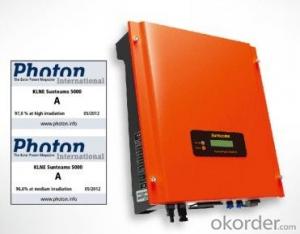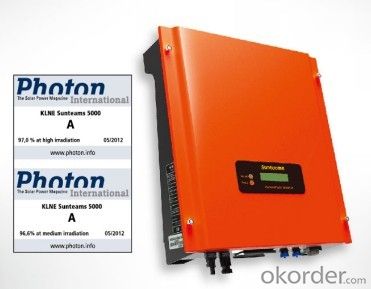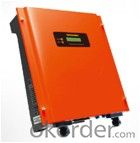Sunteams 5000 on grid inverter with WIFI US standard
- Loading Port:
- Shanghai
- Payment Terms:
- TT OR LC
- Min Order Qty:
- -
- Supply Capability:
- 10000 set/month
OKorder Service Pledge
Quality Product, Order Online Tracking, Timely Delivery
OKorder Financial Service
Credit Rating, Credit Services, Credit Purchasing
You Might Also Like
Sunteams 1500,2000,2500,3000,3600,4000,4600,5000
Sunteams US 1500,2000,2500,3000,3600,4000,4600,5000
1MPPT, single phase
IP 65
50Hz & 60 Hz
with Plug in wifi/ wifi box
with wire box/ without wire box
UL certified
■ For countries with UL certification (UL 1741 / IEEE 1547)
■ For countries with UL certification (UL 1741 / IEEE 1547)
Efficient
■ The CEC efficiency of the inverter can reach 95.0 %-97.5 %
■ Transformerless desi
■ The CEC efficiency of the inverter can reach 95.0 %-97.5 %
■ Transformerless desi
Simple
■ ‘Plug and play’connection for easy installation and maintenance
■ Designed for hanging with simple and easy installation
■ Fanless cooling concept
■ ‘Plug and play’connection for easy installation and maintenance
■ Designed for hanging with simple and easy installation
■ Fanless cooling concept
Communicative
■ RS232/RS485 interfaces as standard
■ Optional Bluetooth technology
■ RS232/RS485 interfaces as standard
■ Optional Bluetooth technology
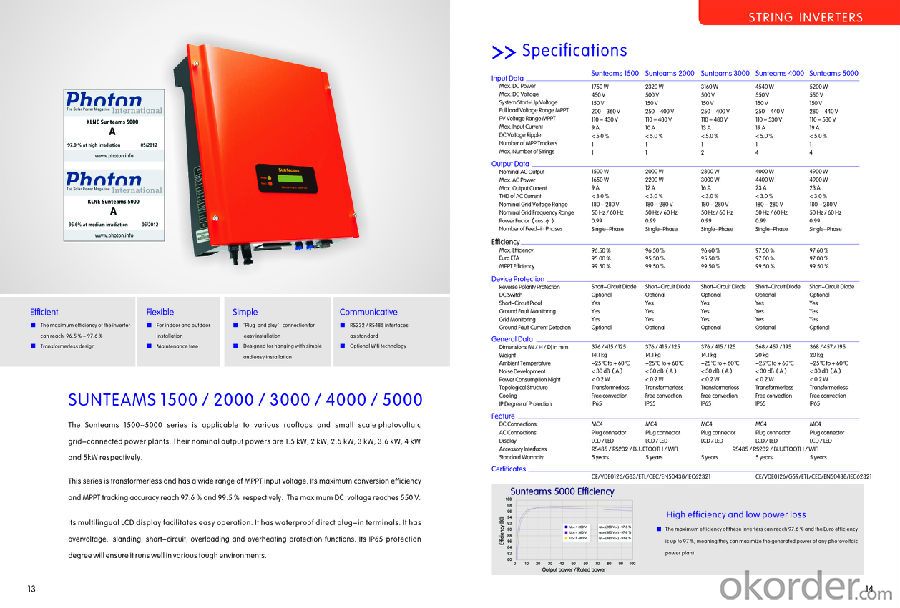
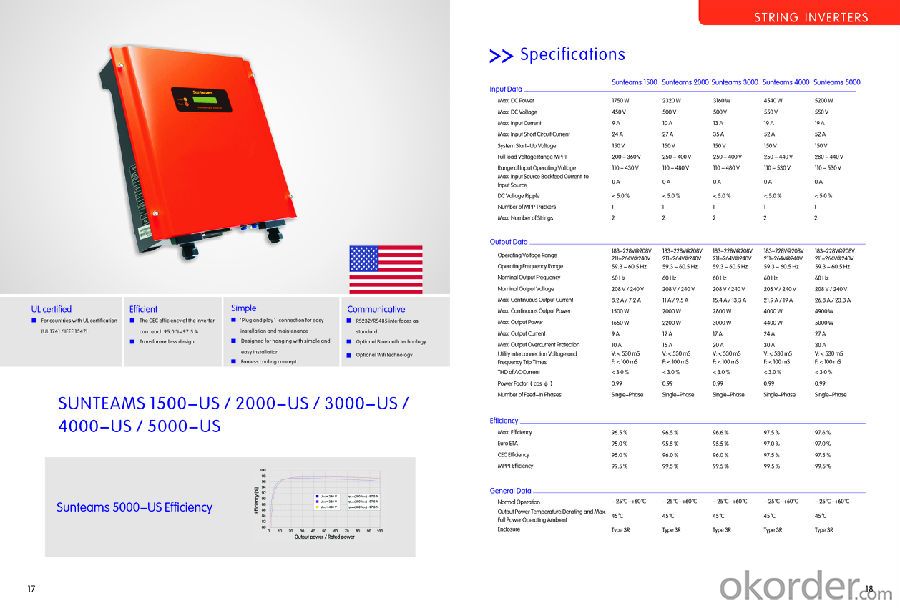

- Q: Are there any government regulations or certifications for solar inverters?
- Yes, there are government regulations and certifications for solar inverters. In many countries, solar inverters must comply with specific standards and regulations set by government bodies. Additionally, various certifications such as International Electrotechnical Commission (IEC) standards, UL listing, and CE marking are commonly required to ensure the safety, performance, and interoperability of solar inverters.
- Q: What is the typical lifespan of the capacitors in a solar inverter?
- The typical lifespan of capacitors in a solar inverter can vary depending on various factors such as the quality of the components used, the operating conditions, and the amount of stress placed on the capacitors. However, on average, the lifespan of capacitors in a solar inverter can be expected to be around 10 to 15 years. Capacitors are electronic components that store and release electrical energy, and they play a crucial role in the functioning of a solar inverter. They help regulate voltage, smooth out fluctuations in power, and provide stability to the electrical system. The lifespan of capacitors in a solar inverter is influenced by several factors. One of the most significant factors is the quality of the capacitors themselves. Higher quality capacitors tend to have better performance and durability, resulting in a longer lifespan. Cheaper or lower-quality capacitors may degrade or fail more quickly. Another factor that affects the lifespan of capacitors is the operating conditions. Solar inverters are typically installed outdoors, exposed to temperature variations, moisture, and other environmental factors. Extreme temperatures, excessive humidity, or exposure to direct sunlight can potentially accelerate the deterioration of capacitors and reduce their lifespan. Additionally, the stress placed on the capacitors can impact their lifespan. This stress can be caused by factors such as voltage fluctuations, high-frequency switching, or overloading of the inverter. If a solar inverter is operated beyond its design limits or experiences frequent power fluctuations, it can put additional strain on the capacitors, potentially leading to premature failure. Regular maintenance and monitoring of the solar inverter can help identify any potential issues with the capacitors and address them promptly. Some manufacturers may offer warranties or provide information on the expected lifespan of their capacitors, which can give an indication of their durability. In summary, the typical lifespan of capacitors in a solar inverter is around 10 to 15 years, but this can vary depending on factors such as component quality, operating conditions, and stress placed on the capacitors. Regular maintenance and monitoring can help ensure the longevity and optimal performance of the capacitors in a solar inverter system.
- Q: How does a solar inverter handle voltage drop?
- A solar inverter is designed to handle voltage drop by continuously monitoring the voltage level of the solar panels. If the voltage drops below a certain threshold, the inverter adjusts its internal electronics to compensate for the drop and ensure a consistent output voltage. This allows the inverter to maintain optimal performance and efficiency even in situations with voltage fluctuations or drops.
- Q: The function of photovoltaic grid - connected inverter
- Finally, a sinusoidal AC output for a grid-connected photovoltaic power generation system is generated by a low-pass filter.
- Q: Can a solar inverter be used with a solar-powered water pump?
- Yes, a solar inverter can be used with a solar-powered water pump. The solar inverter converts the DC power generated by the solar panels into AC power, which is suitable for powering the water pump. This allows for efficient and reliable operation of the pump using solar energy.
- Q: Can a solar inverter be monitored remotely?
- Yes, a solar inverter can be monitored remotely. With the advancement in technology, many solar inverters are equipped with monitoring systems that allow users to remotely monitor and control their solar power systems. This can be done through various methods such as mobile apps, web-based platforms, or even through specialized software. Remote monitoring enables users to track the performance, energy production, and overall health of their solar inverters from any location with internet access.
- Q: Can a solar inverter be used with different battery chemistries?
- Yes, a solar inverter can be used with different battery chemistries as long as the voltage and capacity of the batteries are compatible with the inverter's specifications. However, it's important to note that different battery chemistries may have varying charging and discharging characteristics, so it is advisable to consult the manufacturer's guidelines to ensure optimal performance and safety.
- Q: How do you size a solar inverter for a solar power system?
- To size a solar inverter for a solar power system, you need to consider the maximum power output of the solar panels and the total load you want to power. The inverter's capacity should be equal to or greater than the total power output of the solar panels to ensure efficient energy conversion. Additionally, you should also consider the voltage and current requirements of the load to ensure compatibility with the inverter. It is recommended to consult with a professional or use online sizing tools to accurately determine the appropriate inverter size for your specific solar power system.
- Q: How does a solar inverter handle voltage and frequency regulation?
- A solar inverter handles voltage and frequency regulation by converting the direct current (DC) generated by solar panels into alternating current (AC) that is suitable for use in homes and businesses. It ensures that the voltage and frequency of the AC output are within the acceptable range set by the grid or electrical appliances. This is achieved through the use of control circuitry and algorithms that continuously monitor and adjust the DC input to maintain a stable and consistent AC output.
- Q: What is the role of isolation in a solar inverter?
- The role of isolation in a solar inverter is to provide electrical safety and protect sensitive electronic components. It helps to separate the direct current (DC) input from the alternating current (AC) output, ensuring that any faults or fluctuations in one do not affect the other. Isolation also prevents any potential ground faults, reducing the risk of electric shock and improving system reliability.
Send your message to us
Sunteams 5000 on grid inverter with WIFI US standard
- Loading Port:
- Shanghai
- Payment Terms:
- TT OR LC
- Min Order Qty:
- -
- Supply Capability:
- 10000 set/month
OKorder Service Pledge
Quality Product, Order Online Tracking, Timely Delivery
OKorder Financial Service
Credit Rating, Credit Services, Credit Purchasing
Similar products
Hot products
Hot Searches
Related keywords
